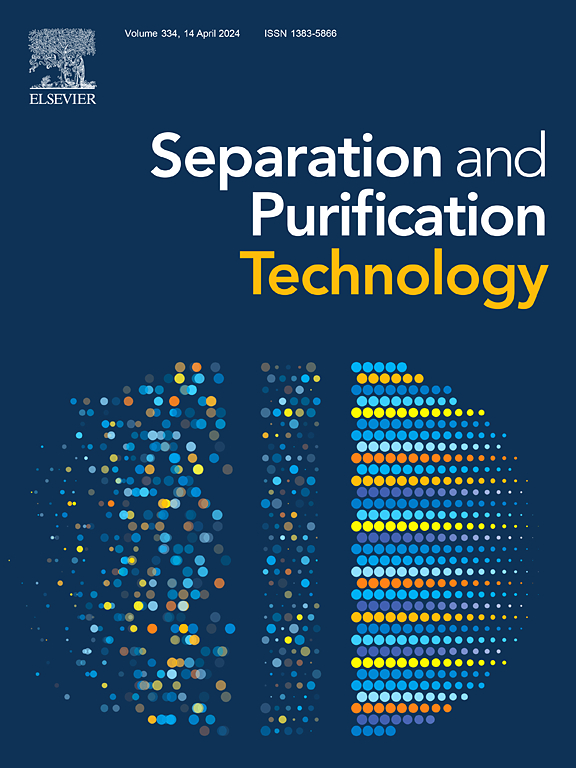Hollow carbon nanocone arrays on carbon fiber cloth as a free-standing electrode for high-performance capacitive deionization
IF 8.1
1区 工程技术
Q1 ENGINEERING, CHEMICAL
引用次数: 0
Abstract
Capacitive deionization (CDI) has been rapidly developed as a competitive desalination technology for obtaining freshwater, wherein the rational design of electrode structures or morphologies plays a crucial role for achieving high-performance CDI process. The most important electrode material is various carbons in forms of 0D nanoparticles or nanocages, 1D nanotubes or nanoscrolls, and 2D nanosheets or nonobelts. Herein, we fabricated highly ordered, highly porous carbon nanocone arrays grown directly on carbon fiber cloth (CNCC) for using as an integrated, binder-free CDI electrode. The CNCC is characteristic of a hollow and end-open structure, graphene-like ultrathin cone walls, abundant pores on the walls, and a large electrochemical active surface area, endowing it with excellent electrical conductivity and unimpeded ion transport pathways. A symmetric CDI desalination cell, which was constructed with a pair of CNCC electrodes, delivered a high electrosorption capacity of 25.9 mg/g in 250 mg/L NaCl solution at 1.2 V, fast adsorption rate (0.43 mg/g min−1), and satisfactory cycling stability (80 % capacity retention after 3 days). This research sheds light on the carbon-nanocone based materials for their preparation and promising applications in CDI and energy storage.将碳纤维布上的中空碳纳米锥阵列作为用于高性能电容式去离子的独立电极
电容式去离子(CDI)作为一种具有竞争力的淡水获取海水淡化技术得到了迅速发展,而电极结构或形态的合理设计对于实现高性能的 CDI 过程起着至关重要的作用。最重要的电极材料是各种碳,如 0D 纳米颗粒或纳米笼、1D 纳米管或纳米卷以及 2D 纳米片或非带状碳。在这里,我们制作了直接生长在碳纤维布(CNCC)上的高度有序、高度多孔的碳纳米锥阵列,可用作集成的无粘结剂 CDI 电极。碳纤维布具有中空和端面开放的结构、石墨烯般的超薄锥壁、壁上丰富的孔隙和较大的电化学活性表面积,使其具有优异的导电性和畅通的离子传输通道。利用一对 CNCC 电极构建的对称 CDI 海水淡化池在 1.2 V 电压下,在 250 mg/L NaCl 溶液中的电吸附容量高达 25.9 mg/g,吸附速率快(0.43 mg/g min-1),循环稳定性令人满意(3 天后容量保持率为 80%)。这项研究揭示了碳纳米酮基材料的制备方法,以及在 CDI 和储能领域的应用前景。
本文章由计算机程序翻译,如有差异,请以英文原文为准。
求助全文
约1分钟内获得全文
求助全文
来源期刊

Separation and Purification Technology
工程技术-工程:化工
CiteScore
14.00
自引率
12.80%
发文量
2347
审稿时长
43 days
期刊介绍:
Separation and Purification Technology is a premier journal committed to sharing innovative methods for separation and purification in chemical and environmental engineering, encompassing both homogeneous solutions and heterogeneous mixtures. Our scope includes the separation and/or purification of liquids, vapors, and gases, as well as carbon capture and separation techniques. However, it's important to note that methods solely intended for analytical purposes are not within the scope of the journal. Additionally, disciplines such as soil science, polymer science, and metallurgy fall outside the purview of Separation and Purification Technology. Join us in advancing the field of separation and purification methods for sustainable solutions in chemical and environmental engineering.
 求助内容:
求助内容: 应助结果提醒方式:
应助结果提醒方式:


